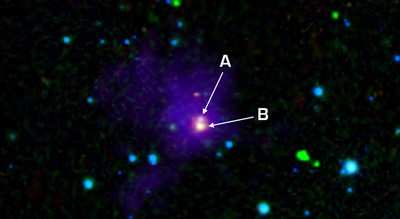Bodies Fall Somewhere Between A Planet And A Star
NASA's Spitzer Space Telescope has contributed to the discovery
of the youngest brown dwarf ever observed -- a finding that, if
confirmed, may solve an astronomical mystery about how these cosmic
misfits are formed.

Brown dwarfs are misfits because they fall somewhere between
planets and stars in terms of their temperature and mass. They are
cooler and more lightweight than stars and more massive (and
normally warmer) than planets. This has generated a debate among
astronomers: Do brown dwarfs form like planets or like stars?
Brown dwarfs are born of the same dense, dusty clouds that spawn
stars and planets. But while they may share the same galactic
nursery, brown dwarfs are often called "failed" stars because they
lack the mass of their hotter, brighter stellar siblings. Without
that mass, the gas at their core does not get hot enough to trigger
the nuclear fusion that burns hydrogen -- the main component of
these molecular clouds -- into helium. Unable to ignite as stars,
brown dwarfs end up as cooler, less luminous objects that are more
difficult to detect -- a challenge that was overcome in this case
by Spitzer's heat-sensitive infrared vision.
To complicate matters, young brown dwarfs evolve rapidly, making
it difficult to catch them when they are first born. In this study,
an international team of astronomers found a so-called "proto brown
dwarf" while it was still hidden in its natal star-forming region.
Guided by Spitzer data collected in 2005, they focused their search
in the dark cloud Barnard 213, a region of the Taurus-Auriga
complex well known to astronomers as a hunting ground for young
objects.
 "We decided to go several steps back in the process when
(brown dwarfs) are really hidden," said David Barrado of the Centro
de Astrobiología in Madrid, Spain, lead author of the paper
on the discovery in the Astronomy & Astrophysics journal.
"During this step they would have an (opaque) envelope, a cocoon,
and they would be easier to identify due to their strong infrared
excesses. We have used this property to identify them. This is
where Spitzer plays an important role because Spitzer can have a
look inside these clouds. Without it this wouldn't have been
possible."
"We decided to go several steps back in the process when
(brown dwarfs) are really hidden," said David Barrado of the Centro
de Astrobiología in Madrid, Spain, lead author of the paper
on the discovery in the Astronomy & Astrophysics journal.
"During this step they would have an (opaque) envelope, a cocoon,
and they would be easier to identify due to their strong infrared
excesses. We have used this property to identify them. This is
where Spitzer plays an important role because Spitzer can have a
look inside these clouds. Without it this wouldn't have been
possible."
Spitzer's longer-wavelength infrared camera penetrated the dusty
natal cloud to observe a baby brown dwarf named SSTB213 J041757.
The data, confirmed with near-infrared imaging from Calar Alto
Observatory in Spain, revealed not one but two of what would
potentially prove to be the faintest and coolest brown dwarfs ever
observed.
Barrado and his team embarked on an international quest for more
information about the two objects. Their overarching scientific
objective was to observe and characterize the presence of this
dusty envelope -- proof of the celestial womb of sorts that would
indicate that these brown dwarfs were, in fact, in their earliest
evolutionary stages.
The twins were observed from around the globe, and their
properties were measured and analyzed using a host of powerful
astronomical tools. One of the astronomers' stops was the Caltech
Submillimeter Observatory in Hawaii, which captured the presence of
the envelope around the young objects. That information, coupled
with what they had from Spitzer, enabled the astronomers to build a
spectral energy distribution -- a diagram that shows the amount of
energy that is emitted by the objects in each wavelength.
From Hawaii, the astronomers made additional stops at
observatories in Spain (Calar Alto Observatory), Chile (Very Large
Telescopes) and New Mexico (Very Large Array). They also pulled
decade-old data from the Canadian Astronomy Data Centre archives
that allowed them to comparatively measure how the two objects were
moving in the sky. After more than a year of observations, they
drew their conclusions.
"We were able to estimate that these two objects are the
faintest and coolest discovered so far," Barrado said. Barrado said
the findings potentially solve the mystery about whether brown
dwarfs form more like stars or planets. The answer? They form like
low-mass stars. This theory is bolstered because the change in
brightness of the objects at various wavelengths matches that of
other very young, low-mass stars.

While further study will confirm whether these two celestial
objects are in fact proto brown dwarfs, they are the best
candidates so far, Barrado said. He said the journey to their
discovery, while difficult, was fun. "It is a story that has been
unfolding piece by piece. Sometimes nature takes its time to give
up its secrets."
These observations were made before Spitzer ran out of its
liquid coolant in May 2009, beginning its "warm" mission.
 ANN's Daily Aero-Linx (04.16.24)
ANN's Daily Aero-Linx (04.16.24) Aero-News: Quote of the Day (04.16.24)
Aero-News: Quote of the Day (04.16.24) Airborne 04.10.24: SnF24!, A50 Heritage Reveal, HeliCycle!, Montaer MC-01
Airborne 04.10.24: SnF24!, A50 Heritage Reveal, HeliCycle!, Montaer MC-01 Airborne 04.12.24: SnF24!, G100UL Is Here, Holy Micro, Plane Tags
Airborne 04.12.24: SnF24!, G100UL Is Here, Holy Micro, Plane Tags Airborne-Flight Training 04.17.24: Feds Need Controllers, Spirit Delay, Redbird
Airborne-Flight Training 04.17.24: Feds Need Controllers, Spirit Delay, Redbird





